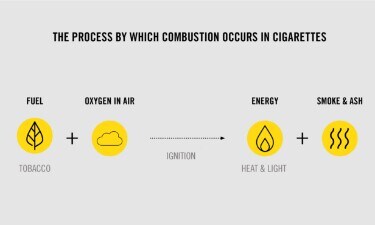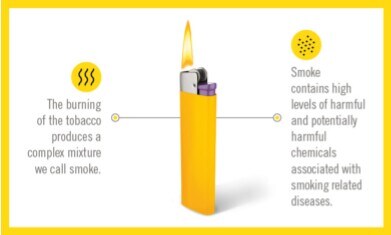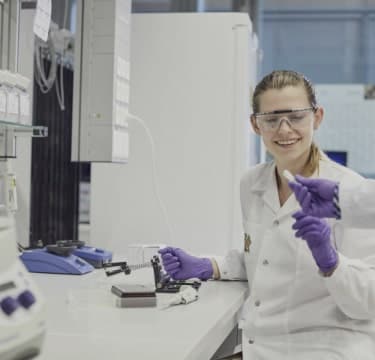THE SMOKE FROM A BURNING CIGARETTE CONTAINS OVER 6,000 CHEMICALS, ABOUT 100 OF WHICH HAVE BEEN IDENTIFIED BY PUBLIC HEALTH EXPERTS AS HARMFUL OR POTENTIALLY HARMFUL.
THE SMOKE FROM A BURNING CIGARETTE CONTAINS OVER 6,000 CHEMICALS, ABOUT 100 OF WHICH HAVE BEEN IDENTIFIED BY PUBLIC HEALTH EXPERTS AS HARMFUL OR POTENTIALLY HARMFUL.
When a cigarette is lit it burns tobacco at temperatures of up to 900°C. This burning process is commonly referred to as ‘combustion.’ The high temperatures created by the process of burning (combusting) tobacco causes the production of the majority and high levels of harmful chemicals detected in cigarette smoke.


In a cigarette, heating (providing energy to) tobacco (fuel) in the presence of oxygen results in combustion producing smoke.
~ 900°C A BURNING CIGARETTE
When a cigarette is lit, it burns at temperatures up to 900°C. At these temperatures the generation of more than 6,000 different chemicals is triggered. Many of which, are considered harmful or potentially harmful.
~ 400°C ONSET OF COMBUSTION
At these high temperatures the process of tobacco combustion begins. The tobacco ignites, resulting in the tobacco burning and smoke being generated.
< 247°C NICOTINE IS RELEASED
Nicotine is one of the reasons why people choose to smoke. It is one of the factors, alongside taste and ritual, that plays an important role in switching adult smokers from cigarettes to smoke-free products. While nicotine is addictive and not risk-free, it is not the primary cause of smoking-related diseases.
SMOKE-FREE ALTERNATIVES
SMOKE-FREE ALTERNATIVES
The best choice a smoker can make: quit tobacco and nicotine altogether. However, many don’t. Thanks to science and technology, smoke-free alternatives such as e-cigarettes, heated tobacco products and snus have been developed for those adults who would otherwise continue to smoke. When scientifically substantiated and manufactured under appropriate quality and safety controls, they can be a better choice than continued smoking. That said, these products are not risk-free and contain nicotine, which is addictive.
THE SCIENTIFIC CONCEPT BEHIND THESE PRODUCTS
THE SCIENTIFIC CONCEPT BEHIND THESE PRODUCTS
As the burning of tobacco produces the vast majority of harmful chemicals in cigarette smoke, eliminating the burning process—as is the case with smoke-free products—means that the levels of harmful chemicals generated can be significantly reduced compared with cigarette smoke. Whether a product reduces emissions of harmful chemicals compared to cigarette smoke has to be scientifically assessed for each product.
FOR SMOKERS TO SWITCH, THE ALTERNATIVES NEED TO BE ACCEPTABLE
FOR SMOKERS TO SWITCH, THE ALTERNATIVES NEED TO BE ACCEPTABLE
For adult smokers to switch to these products completely and abandon cigarettes, they need to find them acceptable in terms of factors such as taste, ritual and sensory experience.

